We are about to finish a R&D project, where we developed and tested crop classification methodology specifically suited for Estonian agricultural, ecological and climatic conditions. We relied mostly on Sentinel-1 and -2 data and used neural network machine learning approach to distinguish 28 different crop types. Results are promising and the methodology is ready for operational service to automate another part of agricultural monitoring.
Using machine learning in crop type classification is not new, and definitely not a revolutionary breakthrough – already for decades different classifiers (Support Vector Machine, Decision Trees, Random Forest and many more) have been used in land cover classification. Recently also neural networks, the wunderkind of machine learning and image recognition, are widely used in crop discrimination. Satellite data, as the main input to classification models, has no serious alternatives, since our aim is to implement it on worldwide scale and in applications, which run near real time. So, why even get excited about another crop type classification study, which exploits same methods and datasets as tens of previous studies?
I can give you one reason. Estonia has been very successful in following European Commission (EC) guidelines and rules in modernizing the EU Common Agricultural Policy. In 2018 EC adopted new rules that allow to completely replace physical checks on farms with a system of automated checks based on analysis of Earth observation data. The same year Estonian Agricultural Registers And Information Board (ARIB) launched the first nation-wide fully automated mowing detection system, which uses Sentinel-1 and Sentinel-2 data and where the prediction model inside the system is developed by KappaZeta. The system has been running for 3 years, it has significantly reduced the amount of on-site checks and increased the detection of non-compliances. In short – saved Estonian and EU taxpayers’ money. Automated crop discrimination is the next step in pursuing the above-mentioned vision and will probably become the foundation of all agricultural monitoring. With proved and tested methodology, it’s highly likely that Estonia will take this next step in the very near future and launch it again on the nationwide level. This is definitely a perspective to be excited about.
Now, let’s see how we tackled “the good old” crop classification task.
Input data
Although algorithms and methods are important to make a difference in prediction model performance, the training data is the most valuable player in this game. In Estonia all farmers who want to be eligible for subsidies need to declare crops online (field geometry + crop type label). This open dataset is freely accessible to everyone and has the permission to re-use and redistribute both commercial and non-commercial purposes. Since the crop type labels are defined by farmers and most of them are not double-checked by ARIB, there can be mistakes (according to ARIB’s estimations, less than 5%). Therefore, for additional validation we ran our own cluster analysis on time-series to filter out obvious outliers in each class.
After we had the parcels and labels, we calculated time-series of different satellite-based, plus some ground-based features (precipitation, average temperatures, soil type). When extracting features from satellite images there are two ways to go: pixel- or parcel-based extraction. We selected the latter and averaged pixel values over the parcel to obtain one numerical feature value per statistic for each point in time (see Figure 1).
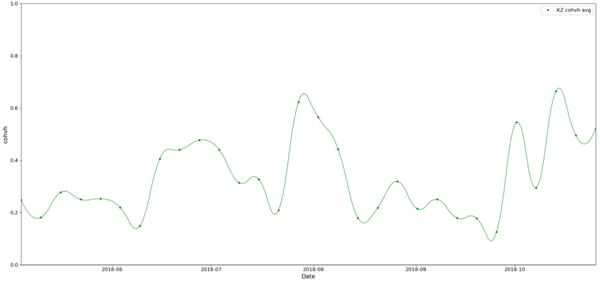
For Sentinel-1 images preprocessing we have developed our own processing chain to produce reliable time-series for several features. From the previous studies it’s known that features (channel values and indexes) from Sentinel-2 images combined with features from Sentinel-1 images (coherence, backscatter) give better classification results than any of these features separately.
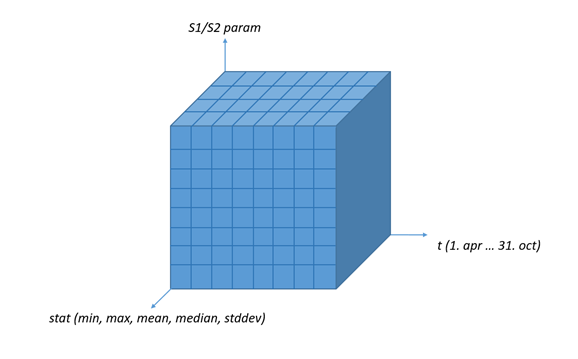
We used data from 2018 and 2019 seasons (altogether more than 200 000 parcels) and aggregated all crop type labels into 28 classes which were defined by the need of the ARIB.Model architecture
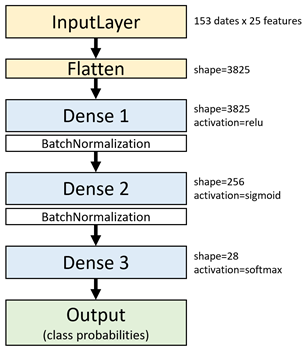
Due to the very unbalanced dataset we had to under-sample some classes and over-sample others for the training data. In small classes we used the existing time-series and added noise for data augmentation.
Model architecture was rather simple – input layer, flatten layer, three fully connected dense layers (two of them followed by batch normalization layer) and output (Figure 3). Our experiment with adding 1D CNN layer after input didn’t improve results significantly. More complicated ResNet (residual neural network) architecture increased training time by approx. 30%, but results were similar to a linear neural network.
Classification results F1 score on validation set (9% of all dataset) was 0.85 and on test set (2% of all dataset) 0.84. In 10 classes the recall was more than 0.9 and in 16 classes more than 0.8. See more from Figure 4 and 5.
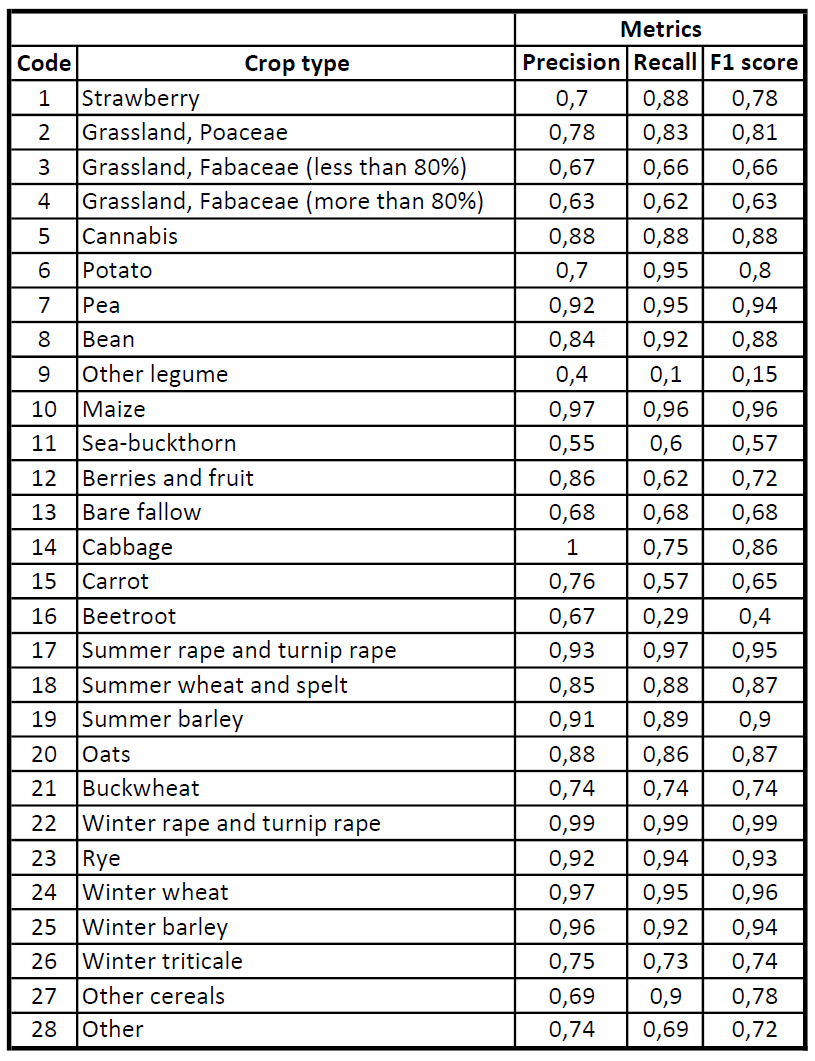

Some features are more important than others
In a near-real time operative system our model and feature extraction would have to be as efficient as possible. For an R&D project we could easily calculate 20+ features from satellite images, feed them all to the model and let the machines compute. But what if not all features are equally important?
They are not. We found that the 5 most important features are Sentinel-1 backscatter (s1_s0vh, s1_s0vv), NDVI, TC Vegetation and PSRI from Sentinel-2. To our surprise, soil type and precipitation sum before satellite image acquisition had low relevance.
The 5 most important features played different role during the season – Sentinel-2 features were more important in the beginning and in the end of the season, while Sentinel-1 features had more effect during mid-season.
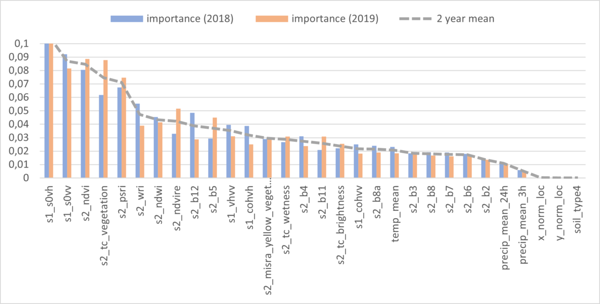
What next?
This project was part of a much larger initiative called “National Program for Addressing Socio-Economic Challenges through R&D. Using remote sensing data in favor of the public sector services.” Several research groups all over Estonia worked on prototypes to use remote sensing in fields like detecting forest fire hazard, mapping floods and monitoring urban construction. Now its up to Estonia’s public sector institutions to take the initiative and turn prototypes into operational services. With this work we have proved, that satellite-based crop classification in Estonia is possible, accurate enough and ready to be implemented as the next monitoring service for ARIB.
If you are more interested about this study, our Sentinel-1 processing pipeline or machine learning expertise, then feel free to get in touch. We have the mentality to share not hide our experience and learn together on this exciting journey.